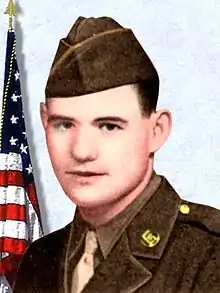Robert H. Dietz
Robert H. Dietz (January 22, 1921 – March 29, 1945) was a United States Army soldier and a recipient of the United States military's highest decoration—the Medal of Honor—for his actions in World War II.
Robert H. Dietz | |
|---|---|
 | |
| Born | January 22, 1921 Kingston, New York |
| Died | March 29, 1945 (aged 24) Kirchain, Germany |
| Place of burial | Wiltwyck Cemetery, Kingston, New York |
| Allegiance | |
| Service/ | |
| Years of service | 1942–1945 |
| Rank | |
| Unit | 38th Armored Infantry Battalion, 7th Armored Division |
| Battles/wars | World War II |
| Awards | Medal of Honor |
| Relations | Dorothy M. Dietz Durling (sister) |
Biography
Dietz joined the Army from his birthplace of Kingston, New York in March 1942,[1] and by March 29, 1945 was serving as a Staff Sergeant in Company A, 38th Armored Infantry Battalion, 7th Armored Division. On that day, during an attack on Kirchain, Germany, he single-handedly killed several German soldiers defending a bridge into the city and then disabled demolition charges which had been placed under a second bridge. He was killed by enemy fire immediately afterwards, but had successfully cleared the way for the American troops to enter the city. For these actions, he was posthumously awarded the Medal of Honor nine months later, on December 17, 1945. Dietz Memorial Stadium in Kingston is named in his honor and memory.
Dietz, age 24 at his death, was buried at Wiltwyck Cemetery in his hometown of Kingston, New York.
Awards and Decorations
Apart from the Medal of Honor Robert H. Dietz received these awards :
 | |||||||||||
| Badge | Combat Infantry Badge | ||||||||
|---|---|---|---|---|---|---|---|---|---|
| 1st Row | American Campaign Medal | European-African-Middle Eastern Campaign Medal | World War II Victory Medal | ||||||
Medal of Honor citation
Staff Sergeant Dietz's official Medal of Honor citation reads:
He was a squad leader when the task force to which his unit was attached encountered resistance in its advance on Kirchain, Germany. Between the town's outlying buildings 300 yards distant and the stalled armored column were a minefield and 2 bridges defended by German rocket-launching teams and riflemen. From the town itself came heavy small-arms fire. Moving forward with his men to protect engineers while they removed the minefield and the demolition charges attached to the bridges, S/Sgt. Dietz came under intense fire. On his own initiative he advanced alone, scorning the bullets which struck all around him, until he was able to kill the bazooka team defending the first bridge. He continued ahead and had killed another bazooka team, bayoneted an enemy soldier armed with a panzerfaust and shot 2 Germans when he was knocked to the ground by another blast of another panzerfaust. He quickly recovered, killed the man who had fired at him and then jumped into waist-deep water under the second bridge to disconnect the demolition charges. His work was completed; but as he stood up to signal that the route was clear, he was killed by another enemy volley from the left flank. S/Sgt. Dietz by his intrepidity and valiant effort on his self-imposed mission, single-handedly opened the road for the capture of Kirchain and left with his comrades an inspiring example of gallantry in the face of formidable odds.
References
 This article incorporates public domain material from websites or documents of the United States Army Center of Military History.
This article incorporates public domain material from websites or documents of the United States Army Center of Military History.
- "Robert H. Dietz". Claim to Fame: Medal of Honor recipients. Find a Grave. Retrieved 2008-02-14.
- "Medal of Honor recipients - World War II (A–F)". Medal of Honor citations. United States Army Center of Military History. June 8, 2009. Retrieved 2008-02-14.